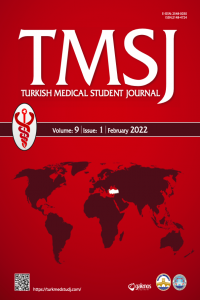JUVENILE POLYP FROM SYMPTOM TO DIAGNOSIS AND THE ROLE OF ULTRASONOGRAPHY: A CASE REPORT
JUVENILE POLYP FROM SYMPTOM TO DIAGNOSIS AND THE ROLE OF ULTRASONOGRAPHY: A CASE REPORT
Juvenile polyp, ultrasonography, colonoscopy,
___
- 1. Jelsig AM, Ousager LB, Brusgaard K et al. Juvenile polyps in den- mark from 1995 to 2014. Dis Colon Rectum 2016;59(8):751-7.
- 2. Chen W, Wang D, Jia L et al. Colorectal polyps in children: a retrospective study of clinical features and the value of ultrasonog- raphy in their diagnosis. J Pediatr Surg 2012;47(10):1853-8.
- 3. Parra DA, Navarro OM. Sonographic diagnosis of intestinal pol- yps in children. Pediatr Radiol 2008;38(6):680-4.
- 4. Lelli JL. Polypoid diseases of gastrointestinal tract. In: Jay LG, James AO, Arnold GC, editors. Pediatric Surgery. Philadelphia: Mosby; 2006.p.1414-26.
- 5. Malandra M, Kaur S, Chogle A. Utility of routine colonic biopsies in pediatric colonoscopic polypectomy for benign juvenile hamar- tomatous polyps. J Pediatr Gastroenterol Nutr 2017;64(4):555-8.
- 6. Thomson M, Tringali A, Dumonceau JM et al. Paediatric gas- trointestinal endoscopy: European Society for paediatric gastro- enterology hepatology and nutrition and European Society of gas- trointestinal endoscopy guidelines. J Pediatr Gastroenterol Nutr 2017;64(1):133-53.
- 7. Vitale V, Di Serafino M, Mercogliano C et al. Giant colon polyp in a child with suspected inflammatory bowel disease: US findings. J Ultrasound 2014;19(1):53-5.
- 8. Wang X, Jia C, Yang H et al. Sonographic features of a ju- venile polyp: a case report and literature review. Clin Imaging 2014;38(2):215-7.
- 9. Hosokawa T, Hosokawa M, Tanami Y et al. Diagnostic per- formance of ultrasound without any colon preparation for de- tecting colorectal polyps in pediatric patients. Pediatr Radiol 2019;49(10):1306-12.
- 10. Nugent KP, Talbot IC, Hodgson SV et al. Solitary juvenile pol- yps: not a marker for subsequent malignancy. Gastroenterology 1993;105(3):698-700.
- 11. Lin HC, Fiorino KN, Blick C et al. A rare presentation and diag- nosis of juvenile polyposis syndrome and hereditary hemorrhagic telangiectasia overlap syndrome. Clin Imaging 2015;39(2):321-4. 12. Brosens LA, van Hattem A, Hylind LM et al. Risk of colorectal cancer in juvenile polyposis. Gut 2007;56(7):965-7.
- ISSN: 2148-4724
- Başlangıç: 2014
- Yayıncı: Trakya Üniversitesi
INVESTIGATION OF THE PARAMETERS THAT MAY PREDICT HEMODIALYSIS FREQUENCY
Gökhan KIRAL, Alperen Taha CERTEL, Irmak İrem ÖZYİĞİT, Begüm SÖYLEYİCİ, Güray AYGÜN, Cenk GÖKALP
DISTANCE EDUCATION IN MEDICAL SCHOOLS: THE EXPERIENCE AND OPINIONS OF ACADEMICIANS AND STUDENTS
Hilal Sena ÇİFCİBAŞI, Berkay KEF, Irmak İrem ÖZYİĞİT, Sezin SAYIN, Aslı GÖZTEPE, Selis Gülseven GÜVEN, Serkan ATICI
JUVENILE POLYP FROM SYMPTOM TO DIAGNOSIS AND THE ROLE OF ULTRASONOGRAPHY: A CASE REPORT
Berkin ERSOY, Özdal ERSOY, Haluk AKMAN, Füsun BABA
MYOCARDIAL INFARCTION DIAGNOSIS AND CARDIAC TROPONINS
Berra KURTOĞLU, Burcu ERKILIÇ, Dilay Yağmur GÜRSEL, Gülsüm ARSLAN, Ogün BACAKSIZOĞLU, Pınar ALTUNDAL, Selin KARA, Yasemin ARDIÇOĞLU
Elif CENGİZ, Fevzi Oktay ŞİŞMAN, Beliz KOÇYİĞİT, Mehmet Gürkan ARIKAN, Tevfik AKTOZ
THE EFFECT OF 5-FU AND RUXOLITINIB ON MITOCHONDRIAL APOPTOSIS IN GLIOBLASTOMA U87 CELL LINE
Gonca AKSU, Oğuzhan DOĞANLAR, Zeynep Banu DOĞANLAR
THE FOURTH HORSEMAN OF 21ST CENTURY: COVID-19 PANDEMIC
İnci KADRİBEY, Fatih Erkan AKAY
PATHOPHYSIOLOGY, CLINICAL FEATURES AND TREATMENT OF MICROVASCULAR ANGINA: A REVIEW
